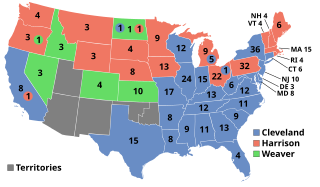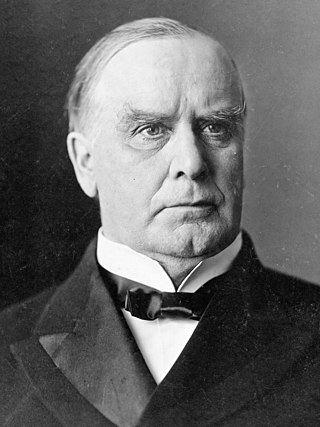
The 1892 United States presidential election was the 27th quadrennial presidential election, held on Tuesday, November 8, 1892. In a rematch of the closely contested 1888 presidential election, former Democratic President Grover Cleveland defeated incumbent Republican President Benjamin Harrison. Cleveland's victory made him the first and, to date, the only person in American history to be elected to a non-consecutive second presidential term. It was also the first of two times incumbents were defeated in consecutive elections—the second being Jimmy Carter's defeat of Gerald Ford in 1976, followed by Carter's subsequent loss to Ronald Reagan in 1980.

The 1896 United States presidential election was the 28th quadrennial presidential election, held on Tuesday, November 3, 1896. Former Governor William McKinley, the Republican nominee, defeated former Representative William Jennings Bryan, the Democratic nominee. The 1896 campaign, which took place during an economic depression known as the Panic of 1893, was a political realignment that ended the old Third Party System and began the Fourth Party System.

The 1900 United States presidential election was the 29th quadrennial presidential election, held on Tuesday, November 6, 1900. In a re-match of the 1896 race, incumbent Republican President William McKinley defeated his Democratic challenger, William Jennings Bryan. McKinley's victory made him the first president to win a consecutive re-election since Ulysses S. Grant accomplished the same feat in 1872. Until 1956, this would be the last time in which an incumbent Republican president would win re-election after serving a full term in office. This election saw the fifth rematch in presidential history, something that would also not occur again until 1956. This was also the first rematch to produce the same winner both times.

The 1908 United States presidential election was the 31st quadrennial presidential election, held on Tuesday, November 3, 1908. Republican Party nominee William Howard Taft defeated three-time Democratic nominee William Jennings Bryan.

The People's Party, also known as the Populist Party or simply the Populists, was a left-wing agrarian populist political party in the United States in the late 19th century. The Populist Party emerged in the early 1890s as an important force in the Southern and Western United States, but collapsed after it nominated Democrat William Jennings Bryan in the 1896 United States presidential election. A rump faction of the party continued to operate into the first decade of the 20th century, but never matched the popularity of the party in the early 1890s.

The 1896 United States presidential election in Montana took place on November 3, 1896 as part of the 1896 United States presidential election. Voters chose three representatives, or electors to the Electoral College, who voted for president and vice president.

The 1896 United States presidential election in New York took place on November 3, 1896. All contemporary 45 states were part of the 1896 United States presidential election. Voters chose 36 electors to the Electoral College, which selected the president and vice president.

The 1896 United States presidential election in Wisconsin was held on November 3, 1896 as part of the 1896 United States presidential election. State voters chose 12 electors to the Electoral College, who voted for president and vice president.

The 1900 United States presidential election in Wisconsin was held on November 6, 1900 as part of the 1900 United States presidential election. State voters chose 12 electors to the Electoral College, who voted for president and vice president.

The 1900 United States presidential election in Maine took place on November 6, 1900 as part of the 1900 United States presidential election. Voters chose six representatives, or electors to the Electoral College, who voted for president and vice president.

The 1896 United States presidential election in Utah was held on November 3, 1896 as part of the 1896 United States presidential election. Voters chose three representatives, or electors to the Electoral College, who voted for president and vice president. This was the first time Utah participated in a presidential election, having been admitted as the 45th state on January 4 of that year.

The 1896 United States presidential election in Idaho took place on November 3, 1896. All contemporary 45 states were part of the 1896 United States presidential election. State voters chose three electors to the Electoral College, which selected the president and vice president.

The 1896 United States presidential election in Colorado took place on November 3, 1896. All contemporary 45 states were part of the 1896 United States presidential election. Colorado voters chose four electors to the Electoral College, which selected the president and vice president.

The 1896 United States presidential election in South Dakota took place on November 3, 1896. All contemporary 45 states were part of the 1896 United States presidential election. Voters chose four electors to the Electoral College, which selected the president and vice president.

The 1896 United States presidential election in Kansas took place on November 3, 1896. All contemporary 45 states were part of the 1896 United States presidential election. Kansas voters chose ten electors to the Electoral College, which selected the president and vice president.

The 1896 United States presidential election in Missouri took place on November 3, 1896. All contemporary 45 states were part of the 1896 United States presidential election. Voters chose 17 electors to the Electoral College, which selected the president and vice president.

The 1896 United States presidential election in Kentucky took place on November 3, 1896. All contemporary 45 states were part of the 1896 United States presidential election. Kentucky voters chose 13 electors to the Electoral College, which selected the president and vice president.

The 1900 United States presidential election in Colorado took place on November 6, 1900. All contemporary 45 states were part of the 1900 United States presidential election. Colorado voters chose four electors to the Electoral College, which selected the president and vice president.

The 1900 United States presidential election in Michigan took place on November 6, 1900, as part of the 1900 United States presidential election. Voters chose 14 representatives, or electors, to the Electoral College, who voted for president and vice president.

The 1908 United States presidential election in Kansas was held on November 3, 1908 as part of the 1908 United States presidential election. Kansas voters chose ten electors to the Electoral College, who voted for president and vice president.
























